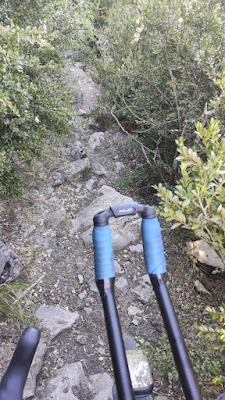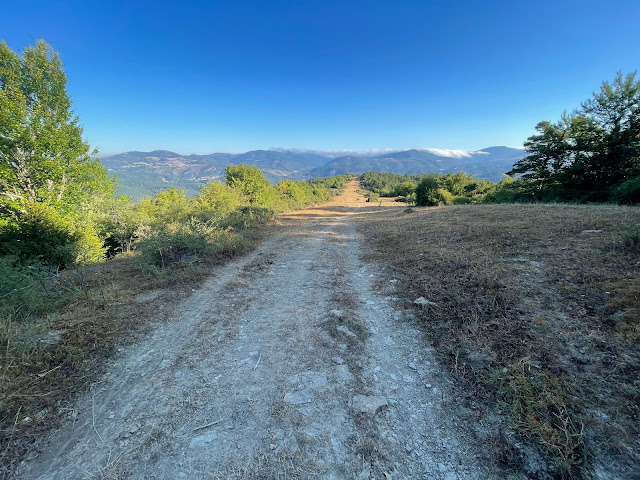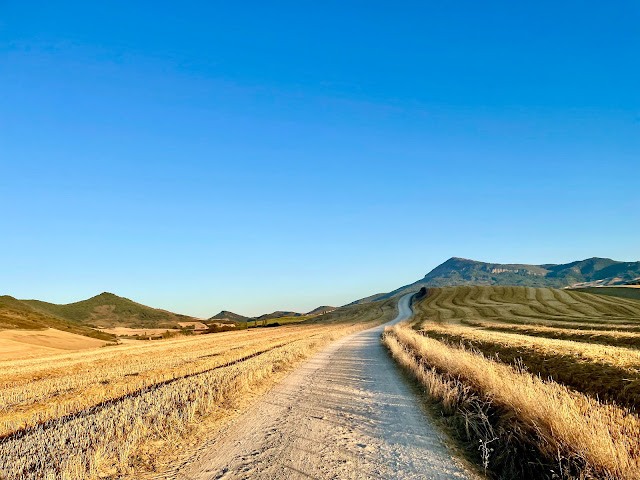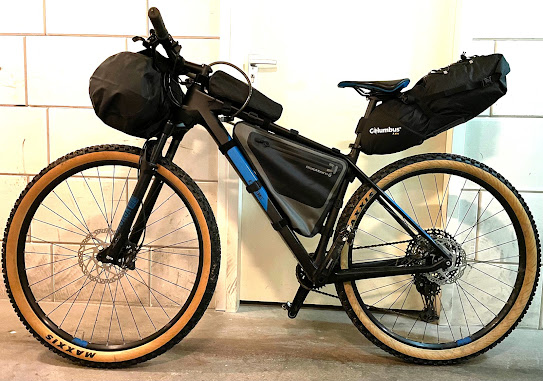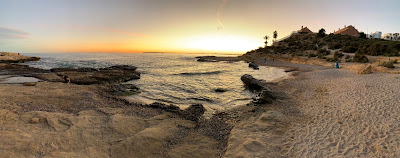After just a little over one month after the Basajaun race, I think it is time to write my recap of the event, think about what I like and didn't like, what I got right and wrong in the preparations and in the race and what I've learned if I'm going to do another one of those ultra endurance bike races. Overall it was a very interesting journey that I enjoyed a lot the preparations and learning process, the thinking over and planning several variants of each day depending on performance and accommodations availability and the sense of freedom from riding without pre-determined stops or checks.
Let's start with the end: I abandoned the race on the morning of the third day after riding 323 kms in 24 hours of moving time or 44 hours elapsed time. And more especially after riding 14 hours on the second day and finishing with a very rough night which I couldn't sleep at all due to cramps in my right leg. The decision to leave the race was surprisingly kind of easy: the next phase on the ride would be crossing the Bardenas desert and the expectation was for a hot weather around 45 degrees Celsius.
Because my leg was cramping so bad during the night, I knew I would suffer severe cramps during the day and I got scared to get stuck in the middle of the desert with complete locked up legs and no place to get water. This has happened to me before and I got stuck for 2 hours. So, despite very disappointed and frustrated, the choice from health and risk point of view was done quickly as I would have to abandoned the race at some point during that day for sure.
PREPARATION
TRAINING - But let's go back to the beginning. The very beginning: when I signed up to the race I thought as this is a gravel race, the type of paths and roads will be smooth or loose gravel with gradients around 8 to 10%. Kind of off road rolling hills. So, I created a training plan starting in November focused on endurance and the idea was to be able to ride between 170 to 190 kms per day, maybe 200 kms. The training was comprised of long rides in the weekend at low-mid intensity, only one interval session and one ride tempo session in the week.
Sadly, that was my first and biggest learning. The terrain of the race at least in the first two days was a 30% gravel, 30% mountain bike, 20% hike & bike/trekking and 20% asphalt. The gravel were OK and as I expected, with ramps around 10% gradient. But there was a lot of MTB trails with very big and loose stones, gradients above 16% and very small paths more akin to the single tracks mtb races we do in South Holland. Worse for me though were the complete off-road or hike and bike places. Areas that you had to walk, carrying your bike (that are heavy as hell) on your back or pushing it thru slippery terrain. More about that below.
All of this to say, my expectation for the race was completely wrong and therefore the training. My plan should have started focusing in strength and muscular endurance and with much higher intensity. Endurance training is a given, but the rides and intervals should have been much harder to prepare me to the very steep climbs. I also should have done a lot of weight training for legs, back & shoulders and core. The mountain bike climbs and especially rocky descends (not to mention carrying the bike) demand a lot from back and shoulders and I had quite some pain at the end of day two. I could see several guys where better overall body fitness managed to climb much better than me. This was a mistake from a road cyclist doing his first gravel ultra endurance event and from lack of knowledge of what to expect.
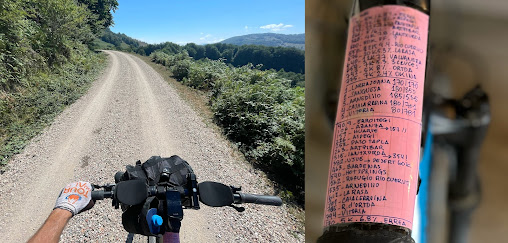
3 - FRAME BAG: this was the most expensive bag on the bike, from Blackburn. I bought it for two reasons: it fit on my frame almost 100% perfect and it had 3 compartments. The below small compartment is where I had my tools (multi-tool from Topeak, repair box with many small things, chain oil and swiss knife), small bike lock self-made and a first aid bag including painkillers, bandage, disinfecting cloth and emergency blanket).
On the main compartment I had my energy bars, maltodextrin powder for breakfast, gels and salt pills and a lot of space where I store sandwiches and tortillas that I bought on the way. In both days I bought a big ham sandwich (Bocata de Jamon) that I would eat half on the spot and save half for dinner, and a big Tortilla, half for dinner and half for breakfast. I also stored there rain riding gear like arm warmers and visibility gilette / vest.
The third and small compartment on the side of the bag was just the bike pump and a roll-on sunscreen. Under this frame and in front of it there were my two spare inner tubes taped to the frame (This picture was taken at the end of day 1, where I had already used the first spare).
4 - SADDLE BAG: This was a not expensive but perfect bag from a Spanish company called Columbus. I saw other riders using it and talked to one of them that also liked it. It was big if I needed (I only actually used 50% of it) and stable enough. In there I had the rest of the food for other days, toiletries which were very basic and a light short & t-shirt for the night.
I had brought enough food to keep me going for half of each of the 5 days I calculated I want to ride. And food for one night in the event I didn't find a place to buy dinner. So, in fact I had food enough for half of the race and the rest I would buy on the way. I believe critical was to have always breakfast ready and I brought with me 4 packages of Decathlon dehydrated granola. It has oats, dehydrated fruit and milk and I used it on both days with a little water. Perfect to start the day. On top of that for each day I had 4 Powerbar gels, 7 small Decathlon fruit bars and 1 Cliff Bars to make sure I had something to hear for every hour. It had also the strap on the top where I could hold things I bought on the way to bring to the hostel, like the water bottle in the picture.
I also carried a backpack with a 3 liters water bladder from Evoc, energy powder for the bottle, mobile, money and bank card. And off course the GPS transponder that was mandatory for tracking the participants. I saw people with more or less stuff, some had spare cycling shorts and jerseys, others have barely anything. My plan was to ride it with one cycling outfit and clean it with anti-bacterial cloth every night. The merino wol jersey was perfect, not smelling at all and keeping me cool. The jersey was a little uncomfortable at the end of day two and maybe I need to think about chamois. The rest was fine, everything just worked.
All in all, not much more to add or remove and I was really happy with the arrangement, weight and easy of access of everything.
THE RACE DAY ONE
The race day started with a not too early breakfast, leaving the bike bag and normal bag stored in the hotel reception for when I came back and small walk to the start. I managed to find a hotel with 5 minutes from the start and they were great with everything, even storing my stuff for 5 days with no charge. We got to the Plaza Spaña at 7:35 and the race started at 8:00 sharp. Around 300 riders with all types of bikes and setup and many with their families and friends. We were escorted by the motorbike police to the limit of the city and then straight into gravel. Even that early in the morning, the temperature was already 25 C although a little overcasted.
The first kilometers were easy rolling hills of gravel the groups were already forming, with fast riders taking off immediately. My plan was to ride 170 kilometers on the first day and not knowing the terrain, I decided to take it easy. That was a good decision as we very fast went into climbing in the forest with very steep hike and bike trails. And that more or less market the pace for the first 90 kms of the day, with up and downs thru dense vegetation and slow mountain bike paths. Around that mark there was a restaurant on top of Sierra de Andia where I made my decision if I would reach my target and called to book the hotel, that was around 110 kms from there in the city of Larrasoaña.
The rest of the day was very good, with rolling hills and tough mountain bike trails. The gravel hills were around 8% climbs and it they were going quite well. This was the best part of the day with incredible feelings in an amazing part of the world that you can't see very easy. The mountain bike climbs were tough and the descends very fast. In one of those I got my first flat when I hit a big and sharp stone with my black tire and had to stop to replace the innertube. We went thru beautiful areas with a stunning views and a lot of nature and a lot of horses. Big horses. In one moment I was with another rider and the horses got spooked and start running the trail with us and that was a little scary as they were very close in front and behind us and we could "feel" the vibration of their powerful roofs on the ground.
I got to the hostel in Larrasoaña around 7:30 and went to the only supermarket in the village just in time to buy my dinner (water and a big tortilla) having done 170 kms in around 10 hours of riding and 11:30 hours since leaving Vitoria in the morning. A total of 1:30 hours of not moving went into eating, replenishing water and fixing the flat tire. After showering, eating and fixing the spare inner tube, I went to bed around 11:00 pm ready for next day wake up at 6 am, with a new plan as I looked better at the profile and knew it would be much harder than day one, with around 4 thousand vertical meters to climb and after done around 3 k.
And quite some people doing hiking as it was the holiday season. But I didn't take pictures of them :)
DAY TWO
The Second day of the race started with me getting ready to leave and finding out that overnight the back tire got deflated. I had to changed it again and found out a very small thorn on the tire. Enough for the air to leat out slowly thru the night. If the tire was tubeless this wouldn't happen and I wouldn't lost that time. Another thing: changing tires with a thru axle is much more work then with a quick release system (just saying!).
While I was finishing pumping the tire another rider passed. We greeted each other, he asked if all was OK and continue. Later we found each other and did most of the day together. It is always good to have some company. I really like the camaderie of most of the riders and everybody was constant checking on each other.
The day started slow as I was feeling tired, with heavy legs and immediately got into a steep long climb. Even though being on asphalt, it was hard to get it going and the cold of the morning was not helping. I stopped to eat the second half of my tortilla, pop some ibuprofen and paracetamol and look at the plan for the day. After that it started getting warm and I felt better. The scenery was nice and the climbs on road were steep but doable.
Off road again the the path brought us thru some forest patch with a lot of cattle gates and points that one need to walk and push the bike. And got my 3rd flat tire and had to stop and change it again, due to another thorn. While I was fixing the tire a hiker passed by and we chat a little. Very nice man. It is good to speak to local language. I was passed by other two riders, but they didn't greeted me... too bad.
At that point, I looked at the watch and got a little shocked: it was already 9:30 in the morning and I had cover only 20 kms. I figured out right there that completing the plan of 180 kms was not possible as the rest of the day promised to be super hard still. I looked immediately at Plan B to ride 150 kms, phone a hostel (Casa Rural for the Camino the Santiago the Compostela) and got a bed for the night! But I fist needed to get there...
After this point the path crossed the Irati forest and ride in the direction of Paso Tapla, the longest of the day. The forest was hard going and with many climbs in tick single track paths. In Azpegi village I stopped to replenish water and chat with a couple of locals. One guy asked me if I was doing the Basajaun and told me he went with the organizer of the race to show the ways around. He told me, half in disbelief of what we were doing and half in sarcasm, to get ready for a very hard climb, thru mountain walk tracks and a river swamp! And that is exactly what we got. I met a group of riders and started the climb together, thru normal gravel roads when the route send us left, to nowhere. It went thru the actual mountain with no path. It was the mountain up hill and small bushes and a lot of huge cows. I couldn't even bike there as the pedals were getting stuck on the bushes and stopping us. Had to push the bike or carry over my shoulder.
And once we reached the top we saw we still had to go thru 3 picks carrying out bikes. Sometimes throwing it and walking thru stores climbing up and down. I little surreal and dangerous (no mobile connection at that moment by the way). The place was also full of huge cows and some white bone of dead cows on the ground. There as a thick fog coming thru and although the scenery promised to be super beautiful, it was really surreal and slow going. It took me around 1 hour to go thru this part and I really didn't like it. This was not cycling but trekking, which is something I was not prepared to do. All the walking are not good for my legs and my lower back.
When we finally finished this part, we needed to go thru a lot of walking again to cross a swamp from a dried river. Again a lot of walking thru very slippery and moss covered stones, going uphill this time. At some points I had to fix my bike to a place, pull myself up hanging to tree branches and pull the bike after me. When we finally got out of the swamp and thinking we would get to ride our bikes, the path was just another hike and bike with people, dogs, everything. Really annoying and not what I was expecting. This was another 1 hour or 90 minutes lost there and I was really not enjoying the day.
From there we went to a long patch of road going uphill. I was just climbing on an easy pace and counting that it woud take me around 20 kms for the base of Paso Tapla. But I made a mistake on counting kilometers on my top tube reference and reached the first part of Paso Tapla top way earlier then expected (when the road end and we would go back to gravel). During the climb another cyclist joined me and we chatted the whole way to the top. He was called Sergio and it as also great company. We talked about what we like and didn't like so far. We really enjoyed the climb which was not too dificult and had great views. It reminded me why I actually like cycling: to go uphill mountains pedaling and not walking!
When we got to the top, we met again Pau, the rider that greeted me in the morning. We chat a little and started going up the 3 together but shortly after this Segio decided he had enough. He was not really enjoying the walking and very technical descends and decide to abandon the race there. I would see him again later after I leave the race myself.
The rest of the climb was on gravel and very nice. Hard but manageable. We were against very heavy wind and I was a little concern about going downhill the other side of the mountain on those conditions. But it turned out the descends were paths among trees and protected. Kind of rolling hills of 10% that were fast to go down as not too technical but tough to go up. What I did expect the whole race to be. From them on until almost the end of the day Pau and I rode together.
At the end of this section we had around 100 kms in the legs and were happy to find a little restaurant close to the village called Aribe. This was 16:30 in the afternoon and it taken me 10 hours to get there. We stopped there to buy food, drink a couple of Coca-colas and a coffee. Other riders were stoping there as well and we chatted with them. Everybody was complaining about the route and the places they made us go thru. A couple of guys were actually drinking beer and smoking, which I found incredible.
I looked at my watch and realized it was already 17:00 and wanted to get going. I knew the progress from there to the village where I had the hotel would be slow as we needed to go thru 5 official climbs, not counting the unmarked ones. I started riding alone and Pau catchup with me just a little after. From there to the hostel was a 50% / 50% mix of road (with some nice descends) and very tough gravel climbs, with ramps around 12% gradient. Tough going. In some of those ramps we had to dismount and push our bikes because they went to 18% with very loose sand.
When we were getting close to Monreal, Pau decided to stop to have dinner in Urroz, a small village on the way. And there is where we separated. All I wanted to do was to ride to the hostel. The last 15 kilometers were tough and I even called the hostel to let them know I was still coming. I crossed many grass fields on the way, which were glowing gold with the sunset light while the farmers still worked on the hey harvest. I was really tired but this was a nice road and I manage to squeeze some enjoyment from the nice views.
I got the hostel at 22:00 exactly. 14 and half hours after I left in the morning and was exhausted. The owner was a very nice guy and he is used to receive broken people from the Camino. As it was already late in the evening, he sent me immediately to the restaurant in front of the hostel before the kitchen closed. I got there the biggest hamburger with fries I could get, a coca-cola and a huge bottle of water. Warm food never tasted so good :).
DAY 3
After doing the last preparations for next day and taking some painkillers because I had a lot of shoulder pain, I went to bed around midnight. But the night wasn't a good one. My right leg started cramping strongly and I was waking up almost every 30 minutes. I didn't manage to sleep well even after doubling my dosis of ibuprofen. I woke up in the morning around 6:30 and did a balance of my options.
The next phase of the race would be thru the Bardenas desert and the forecast for the day was of 45 degrees Celsius. We were going thru the heat wave in the Spanish summer. My concern was if I would have a severe cramp attack that day, I could get stuck in the middle of the desert. With no way to move forward or back, I could ran out of water and that would be a real problem. I had similar situations in past rides / race but never in a place so remote. I decided that this was too risky and decided to quit the race.
From there it was a matter of riding the bike back slowly towards Pamplona, get a train to Vitoria and figure out how to get back to Alicante to enjoy the rest of the vacation with my girlfriend. In Pamplona I learn that carrying bikes on trains in Spain is a little more complicated and if you wan to bring it on a national big train you need to have it dismantled and in a bag, while in the regional train you can carry them as they are. But for that train I needed to wait another 4 hours in the station. I almost decided to go back by bike but it was too hot and better to wait listening to music and watching the people. And I was happy to meet Sergio there, the rider that left the race the day before. That helped to pass the time as we chat a lot about other similar races in Spain and France, about training and everything. Great guy!
I was disappointed but as mentioned in the intro of this long story, I knew that was the sensible thing to do. I prioritized my health (one other ride continue and had a heat stroke in the desert and they had to call a helicopter for him). Another big part of the reason for leaving the race was that I didn't enjoy big part of the two days. The hike & bike / carring bike / walking was not what I was prepared to do. Maybe I would feel different if I was stronger and my training would have been better tailored. But that was not the case.
Still, all in all, this was a great experience. I saw many amazing places, met great people from overall in Spain and had fun in the middle of the whole ordeal. I did one third of the event and now need to think if the feeling of unfinished business is strong enough to make me try again next year. As my girlfried said: right after a mother delivers a baby you don't ask if she wants to have another one. We need to give a little time! :). So, maybe I will try again, maybe not. Time will tell :)
Some more pictures of day 2 below.
PS: This was a brain dump. No editing or embelishing. Raw as it comes...









